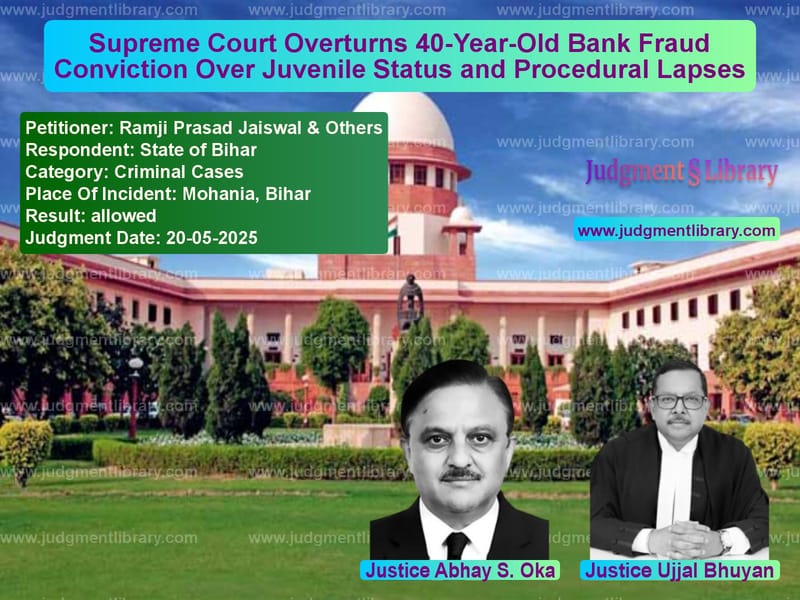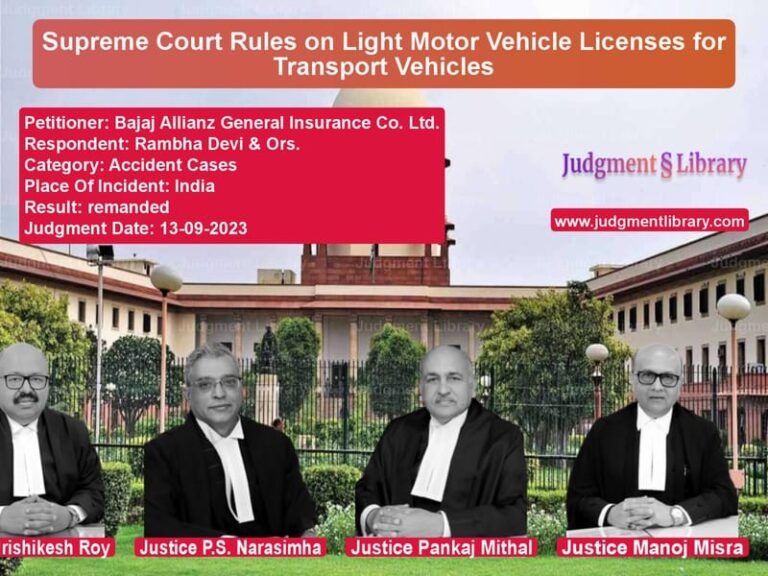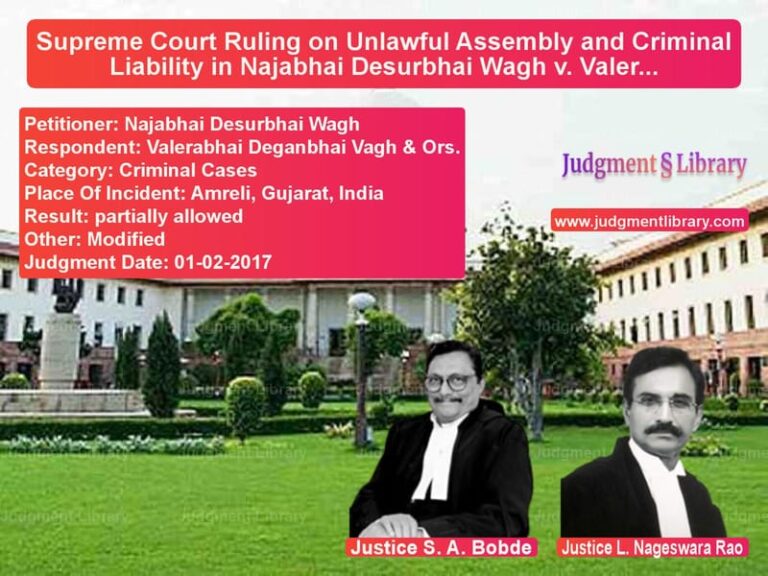Supreme Court Overturns 40-Year-Old Bank Fraud Conviction Over Juvenile Status and Procedural Lapses
In a landmark judgment that highlights the importance of procedural fairness in criminal trials, the Supreme Court has overturned the convictions of three individuals in a four-decade-old bank fraud case. The decision delivered on May 20, 2025, sets aside the convictions based on two crucial grounds: one accused being a juvenile at the time of offence and serious procedural lapses in the trial process that violated the fundamental rights of the accused.
The case dates back to 1982-83 when a massive banking fraud worth ₹13.29 lakhs (approximately ₹13.29 million) was allegedly perpetrated at the State Bank of India’s Agriculture Market Yard Branch in Mohania, Bihar. The prosecution claimed that bank officials conspired with local businessmen to create fake transport receipts and bills to illegally withdraw funds from the bank.
The Four-Decade Legal Battle
The legal journey of this case is a story in itself. The FIR was registered by CBI on June 23, 1983, and charges were filed on December 31, 1984. After a prolonged trial spanning over two decades, the Special Judge convicted all accused on May 29, 2006. The High Court upheld the conviction on November 24, 2011, leading to the appeal before the Supreme Court.
Read also: https://judgmentlibrary.com/supreme-court-cancels-bail-in-murder-case-land-dispute-turns-deadly/
The three appellants in this case were Ramji Prasad Jaiswal and his two sons Ashok Kumar Jaiswal and Bal Mukund Jaiswal. They were convicted under Sections 420 (cheating), 468 (forgery for purpose of cheating), 471 (using as genuine a forged document) and 120B (criminal conspiracy) of the Indian Penal Code read with provisions of the Prevention of Corruption Act, 1947.
The Juvenile Justice Argument
One of the most significant aspects of this case was the plea of juvenility raised by Bal Mukund Jaiswal (appellant no. 3). His legal team presented a matriculation certificate from the Bihar School Examination Board showing his date of birth as December 24, 1965. This meant that during the period of the alleged offence between September 1982 and December 1982, he was approximately 17 years old – legally a juvenile.
The Supreme Court had earlier, in its order dated September 21, 2012, directed the Special Judge to conduct an inquiry into Bal Mukund’s juvenility claim under Section 7A of the Juvenile Justice (Care and Protection of Children) Act, 2000. The inquiry confirmed that Bal Mukund was indeed a juvenile during the relevant period.
The Court emphasized the importance of juvenile justice provisions, noting: “As per the proviso, a claim of juvenility could be raised before any court and at any stage. If upon such inquiry, court found the person to be a juvenile on the date of commission of the offence, it had to forward the juvenile to the Juvenile Justice Board for passing appropriate orders and the sentence if any, passed by a court, would be deemed to have no effect.”
However, given that more than four decades had passed since the offence, the Court found it “neither possible nor feasible to remand the case of appellant No. 3 to the concerned Juvenile Justice Board.” Consequently, the conviction and sentence against Bal Mukund Jaiswal were set aside on the ground of juvenility.
The Critical Procedural Lapse
The second and equally important ground for setting aside the convictions was the serious procedural irregularity in recording the statements of the accused under Section 313 of the Code of Criminal Procedure (CrPC). This provision requires the court to examine the accused and enable them to explain any incriminating circumstances appearing in the evidence against them.
The Supreme Court found that the trial court had recorded the statements of all three appellants in a “most mechanical manner” by asking only four identical general questions without putting specific incriminating evidence to them.
The Court reproduced the questions put to the accused: “1. Have you heard the statements given by the witnesses? 2. It has come in the evidence that 14 consignment notes/transport receipts Nos. 616, 617, 140 to 148, 1101, 1102, 625, 635 and 1104 were prepared in the names of M/s Bansal Stores, Mohania and Vishnuji Bhandar, Mohania during the period August to December, 1982? 3. It has also come in the evidence that you in collusion with accused Ajay Kumar Srivastava, Shiv Narain Bansal, Chaithakh Singh, Bal Mukund Jaiswal and Ashok Kumar Jaiswal in furtherance of a particular conspiracy transacted with the State Bank of India on the basis of forged and fabricated documents and after depositing Rs. 71,456.00, you cheated the bank of Rs. 12,57,810.00? 4. Do you have to say anything in your defence?”
The Legal Principles on Section 313 CrPC
The Supreme Court extensively discussed the legal principles governing Section 313 CrPC, referring to several landmark judgments. The Court quoted from Shivaji Sahabrao Bobade Vs. State of Maharashtra: “It is trite law, nevertheless fundamental, that the prisoner’s attention should be drawn to every inculpatory material so as to enable him to explain it. This is the basic fairness of a criminal trial and failures in this area may gravely imperil the validity of the trial itself, if consequential miscarriage of justice has flowed.”
The Court also cited Dhamidhar Vs. State of Uttar Pradesh, which outlined “the proper methodology to be adopted by the court while recording statement of an accused under Section 313 CrPC is to invite the attention of the accused to the circumstances and substantial evidence in relation to the offence, for which he has been charged and invite his explanation.”
In Raj Kumar Singh alias Raju alias Batya Vs. State of Rajasthan, the Court had emphasized that “In a criminal trial, the purpose of examining the accused person under Section 313 CrPC is to meet the requirement of the principles of natural justice i.e. audi alteram partem. This means that the accused may be asked to furnish some explanation as regards the incriminating circumstances associated with him, and the court must take note of such explanation.”
The Court summarized the law from Raj Kumar alias Suman Vs. State (NCT of Delhi) as follows: “The law consistently laid down by this Court can be summarised as under: 22.1. It is the duty of the trial court to put each material circumstance appearing in the evidence against the accused specifically, distinctively and separately. The material circumstance means the circumstance or the material on the basis of which the prosecution is seeking his conviction. 22.2. The object of examination of the accused under Section 313 is to enable the accused to explain any circumstance appearing against him in the evidence. 22.3. The Court must ordinarily eschew material circumstances not put to the accused from consideration while dealing with the case of the particular accused. 22.4. The failure to put material circumstances to the accused amounts to a serious irregularity. It will vitiate the trial if it is shown to have prejudiced the accused.”
The Court’s Analysis and Conclusion
After examining the facts of the case against these legal principles, the Supreme Court concluded: “The manner in which the trial court had recorded the statements of the appellants under Section 313 CrPC was not at all in tune with the requirements of the said provision as explained by this Court.”
The Court noted that “Four questions generally were put to the appellants, that too, in a most mechanical manner. These questions did not reflect the specific prosecution evidence which came on record qua the appellants. As all the incriminating evidence were not put to the notice of the appellants, therefore, there was a clear breach of Section 313 CrPC as well as the principle of audi alteram partem. Certainly, this caused serious prejudice to the appellants to put forth their case.”
The Court considered whether the case could be remanded to the trial court to cure this defect but concluded: “As we have already noted, the period during which the offence was allegedly committed was from September, 1982 to December, 1982. Trial was concluded on 29.05.2006. Nineteen years have gone by since then. At this distant point of time, instead of aiding the cause of justice, it will lead to miscarriage of justice if the case qua the two appellants are remanded to the trial court to restart the trial from the stage of recording the statements of the accused persons under Section 313 CrPC.”
The Court therefore held that “appellants are entitled to the benefit of doubt because of such omission in the recording of their statements under Section 313 Cr.P.C. since the trial court had relied on the evidence adverse to the appellants while convicting them.”
Broader Implications
This judgment reinforces several fundamental principles of criminal jurisprudence. First, it underscores the importance of procedural fairness and the right of every accused to a fair trial. The Supreme Court’s insistence on strict compliance with Section 313 CrPC demonstrates that procedural safeguards are not mere technicalities but essential components of justice.
Second, the judgment highlights the courts’ duty to protect the rights of juvenile offenders, even when the claim of juvenility is raised decades after the offence. The progressive interpretation of juvenile justice laws ensures that young offenders are treated with the sensitivity and protection that the law intends.
Third, the decision acknowledges the practical realities of delayed justice. By refusing to remand the case after four decades, the Court recognized that at some point, the pursuit of perfect procedure must yield to the realities of time and the rights of individuals who have lived under the shadow of conviction for decades.
The Supreme Court’s decision serves as an important reminder to trial courts about their duty to ensure that every accused understands the case against them and has a meaningful opportunity to respond. It reaffirms that in criminal justice, how we arrive at the truth is as important as the truth itself.
As the Court canceled the bail bonds of the appellants and finally brought closure to this four-decade legal battle, it demonstrated that justice, though delayed, must ultimately be grounded in fairness, procedure, and respect for the rights of the accused – whether guilty or innocent.
Petitioner Name: Ramji Prasad Jaiswal & Others.Respondent Name: State of Bihar.Judgment By: Justice Abhay S. Oka, Justice Ujjal Bhuyan.Place Of Incident: Mohania, Bihar.Judgment Date: 20-05-2025.Result: allowed.
Don’t miss out on the full details! Download the complete judgment in PDF format below and gain valuable insights instantly!
Download Judgment: ramji-prasad-jaiswal-vs-state-of-bihar-supreme-court-of-india-judgment-dated-20-05-2025.pdf
Directly Download Judgment: Directly download this Judgment
See all petitions in Fraud and Forgery
See all petitions in Juvenile Justice
See all petitions in Judgment by Abhay S. Oka
See all petitions in Judgment by Ujjal Bhuyan
See all petitions in allowed
See all petitions in supreme court of India judgments May 2025
See all petitions in 2025 judgments
See all posts in Criminal Cases Category
See all allowed petitions in Criminal Cases Category
See all Dismissed petitions in Criminal Cases Category
See all partially allowed petitions in Criminal Cases Category







